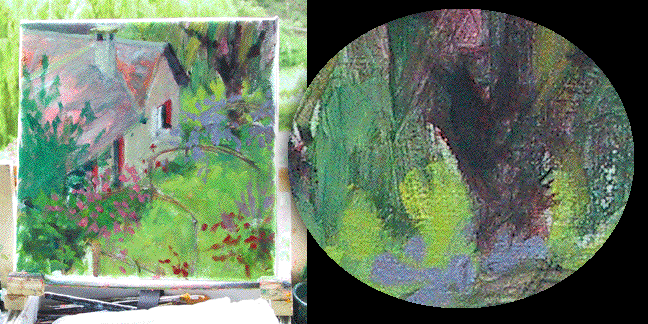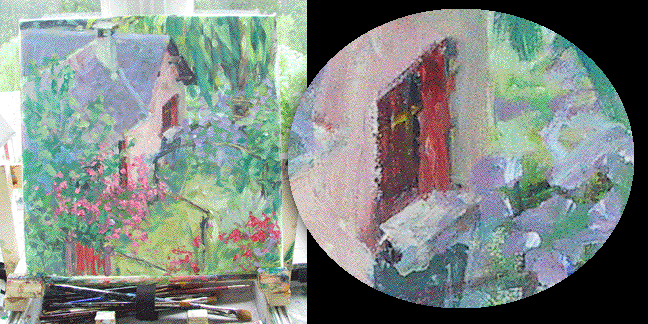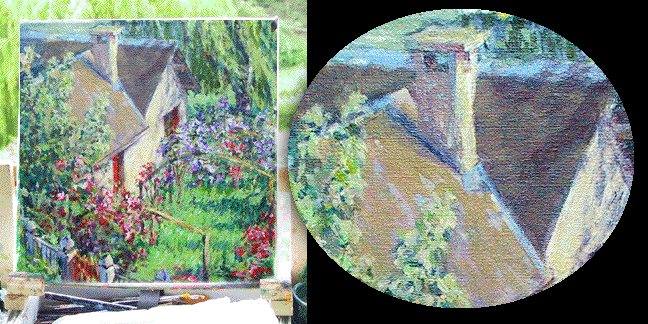
 I recently had the pleasure of instructing a workshop in Monet's garden for the second time. There is nothing quite like painting en plein air in the master's garden, birds singing, breezes carrying the scent of oceans of flowers, while furiously trying to capture the light and joyous colors. Painting in the garden was limited to Mondays and a few designated hours. We were free to paint in and around the village of Giverny at any time rich with subject material including hills, pastures, charming cottages, and delightful rooftops. Even while in my tiny hotel room, I was itching to paint. I had the perfect view of a lovely private garden just below my window. I'd sneak a peak when dashing back and forth between sessions. At any time of day the changing light was interesting, sometimes dramatic. The days were very long, the light lasted till nearly 10 pm. Dare I paint an outdoor scene from my window? Would this still be considered a plein air painting? Pictured above is the view from my window. Sun coming from the West. Even with the parking lot, it was appealing! |
 I reached the point where I just had to paint this scene. So I set up my pack equipment in the windowsill then made a quick charcoal sketch to accurately work through architectural features. The canvas was only 12x12 which is small for such a scene. I welcomed the challenge of creating an intimate feel without crowding the subject. Charcoal also allowed the flexibility to move things as needed. Since I would have the luxury of painting for a few days (a few minutes each time, and even during the rain), I worked just a bit slower than I would have if painting on the field. Sketch completed...now time for some paint! I will use cobalt blue, cadmium yellow medium, lemon yellow, vermilion, cadmium red medium, alizarin crimson, viridian & white. |
 Using acrylics I apply a wash of warm vermilion/cadmium red medium with a large brush. When nearly dry, I block-in the largest areas with local color. You can see the warmth of the red wash glowing through on this overall cool-colored scene. Staying loose for as long as possible helps me make changes/adjustments all along the way. I place in the darkest darks and mid-tones to anchor the composition. Notice that I remove one arbor and replace with the gate/fence to open up the foreground. This change will assure directing the viewer's eye inside the painting. |
 Next, building the painting with a second layer of paint. I apply more color to the flower areas. But even using dabs of color I look for masses. Otherwise, the painting would fall apart visually. I also vary my strokes to achieve visual texture and movement. I try to paint as fast as my eye can see. This is always a challenge, but when I paint this way, I know that I am painting what I "see", not what I think I see. Things are still loose enough for me to make necessary changes. If the painting becomes too loose however, I just stop to restate the subjects before moving on. |
 I finally get to the fun part -- really painting. I step down to a medium-sized brush to push/pull the values and colors. The lights get lighter, the darks become richer, and colors begin to glow. I define crisper edges as well diffused ones to achieve depth. The last touches are done with a still smaller brush, but never a tiny one unless I am creating a very tight, realistic painting. The final strokes applied are the highest highlights and very darkest darks in the scene. Visit L. Diane Johnson's website to view more of her work. |
© 2001, L. Diane Johnson
Artshow.com | Artist Interviews and Demonstrations
Copyright © 2001 Artshow.com. All rights reserved.
Web pages and artwork at this site may not be duplicated or redistributed in any form without express permission.